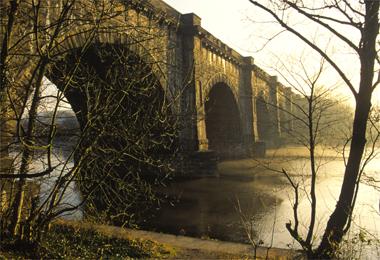- Home
- Morecambe & Heysham
- Historic Lancaster
- Lune Valley & Countryside
- Carnforth & Surrounding Area
- Short Break Ideas
- Accommodation
- What to See and Do
- Food and Drink
- Festivals and Events
- Towns & Villages
- Brochure and Leaflet Request
- Contact Us
- Maps and Travel
- Books and Gifts
- Conferences
- Interesting Facts and Figures
- Group Visits
- Useful Links
- Downloads
- Industry Pages
Halton Village, St Wilfrid's Church and Lune Aqueduct

Contact Info
Halton
Lancashire
LA2 6QE
Tel: 01524 32878
St Wilfrid’s Church, Halton. The tower was built around 1597 and the original church was twice built and demolished. The existing church is by Paley and Austin, erected between 1876 and 1877. Inside and outside of the church are several very old crosses, most of which have been restored. The churchyard contains an elegant classical mausoleum built in 1775 for members of the Bradshaw family.
Viking Cross, St Wilfrid’s Churchyard. This is a good example of a Viking Cross. This example, 4.5m in height, has both Christian symbols and the pagan story of Sigurd carved into the sandstone, dating from the 11thC. In 1635 the top of the cross was removed, with the remainder used as a sundial. It was the late 19thC which saw the addition of a new top to the cross.
Castle Hill Motte and Bailey, Halton. This is one of the series of structures strategically located along the Lune Valley. Earl Tosti was Lord of the Manor at Halton and was killed in the Battle of Stamford Bridge in 1066. In the same year, his brother, Harold, also died at the Battle of Hastings.
Former Halton Station, south bank of the Lune. Walkers and cyclists using the cycleway between Caton and Lancaster will pass the former railway station at Halton, now a boat house for Lancaster University Rowing Club. Passengers from Halton had to cross the river to reach the railway station which is actually in the Parish of Quernmore! The present buildings replaced the original station which burnt down in 1907, following a disastrous fire ignited by sparks from a passing train which landed on 20 wagons carrying Naphtha.
The Lune Aqueduct, Halton. Opened in 1797, the aqueduct, which is is 664ft long by 51ft high, carries the Lancaster Canal over the River Lune. The architect was John Rennie and the engineer was Alexander Stephens. The aqueduct is regarded as one of the finest examples of canal engineering in the country, combining great strength with great elegance. The railway that once passed under one of its arches is now part of the Millennium Trail.







